Share
Black Friday and Cyber Monday is the biggest opportunity for retailers to rake in heavy profits.
But the risk is just as high as the reward.
You're battling against high-decibel promotional campaigns, decision fatigue, short attention spans, and much more. Even the slightest mistakes can tank your performance and make your BFCM sale a flop.
In this article, we'll break down the six most common pain points for eCommerce businesses during Black Friday Cyber Monday. And tell you the best way to turn all these pains into gains.
6 eCommerce pain points during Black Friday Cyber Monday
Are you gearing up for the biggest retail shopping season? These are the six most critical challenges that can derail progress and hurt your sales.
1. Oversaturation: Standing Out Amid the Noise
From big retailers to small-time eCommerce brands, everyone is vying for shoppers' attention during the BFCM season. Social media feeds, email inboxes, SMS texts, and billboards are saturated with ads and offers.
The result? Decision fatigue.
Online shoppers are overwhelmed with this constant influx of information and get trapped in a paradox of choice. They’re unable to make an informed buying decision because choosing between so many options will take hours or even days.
But more importantly, the biggest challenge for eCommerce businesses is the struggle to cut through all this noise and make a strong impact on shoppers.
Most brands go with generic marketing campaigns, trying to appease potential customers with hefty discounts. This can dilute your market reputation and make it more challenging to stand out, especially when bigger brands offer better deals.
2. Customer Engagement: Captivating and Retaining Interest
Besides big deals and discounts, BFCM brings a significant amount of sensory overload for shoppers. That means people's attention spans shrink even more when inundated with so much information. This naturally makes it difficult for brands to engage meaningfully with potential customers.
When inboxes and social media feeds are cluttered with ads, you don’t have a strong enough medium to capture buyers’ attention and gain their trust.
So, another huge challenge is getting on new shoppers’ radar and re-engaging your existing customers to buy from you.
But that’s just one part of the problem. At the peak of the Black Friday Cyber Monday season, most shoppers develop a "deal-first" mindset. That means good discounts > brand loyalty. It's a purely transactional approach with little emphasis on brand values and reputation.
This makes your tried-and-tested audience engagement techniques ineffective because buyer behavior shifts to prioritize price cuts and flash sales.
3. Conversion Rates: Addressing Low Conversion Rates
The Black Friday Cyber Monday frenzy starts just before the holiday season. People are shopping for festivities and gifting in large numbers. In fact, Google Trends data indicates how shopping-related searches containing “deals” grew by over 2,300% around the BFCM weekend in 2022.
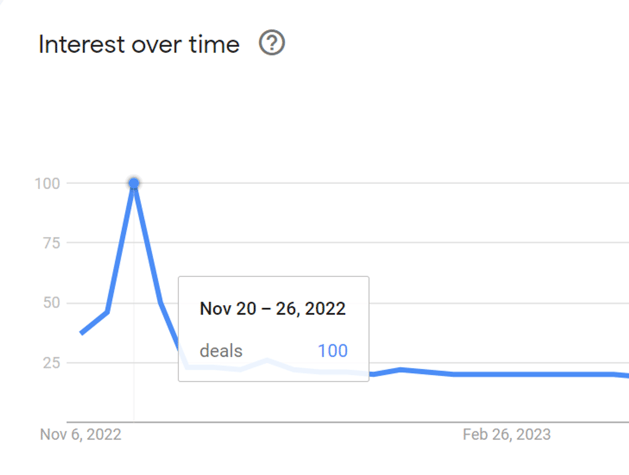
Such high demand means there's almost no room for errors if you're an eCommerce business. Shoppers are spoilt for choice, and even the slightest friction in the buying process will lead to a drop-off.
That’s a big reason why some brands see terrible conversion rates around the peak shopping season. Something in their buying journey is broken, and they haven’t fixed it.
Another possible reason for low conversion rates can also be decision fatigue. As we discussed earlier, the sheer volume of ads and deals during this time can cause indecisiveness and tire out shoppers. When people aren't 100% confident of buying something, they'll probably abandon their carts and bounce.
4. Page Optimization: Load Times and Layout Issues
As an eCommerce business owner, you’d think higher traffic to your online store is a good thing, right? Wrong.
The BFCM sale can create an unpredictable, never-seen-before spike in your website traffic—to the extent that your website can't handle the traffic anymore. Despite all your preparations, this sudden influx of visitors inevitably slows down loading times or, worse, crashes your site.
Slow loading times and inability to access the store create a poor buyer experience. Add to that an unoptimized mobile website, and you’re looking at a full-blown crisis.
If your online store isn’t mobile-friendly, you’re leaving money on the table because nearly half (49.62%) of shoppers will do their holiday shopping on mobile. The bottom line: a slow-loading website with poor navigation on mobile can become a major setback during BFCM and hit your revenue engine.
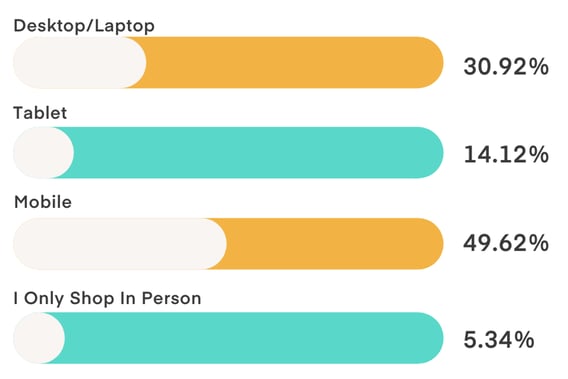
5. Video CRO: Harnessing Video Content for Conversions
Video content has been one of the most popular retail success strategies for a few years now. Come BFCM season, eCommerce brands put their most creative minds to work to create spectacular video campaigns.
Why? Because videos convey real emotions and make people resonate with your brand.
But there’s a catch even with this tactic. Consumers don’t spend enough time watching and engaging with longer videos. And with so much content already overflowing on different platforms, it’s not easy to create compelling videos that pique people’s curiosity.
Besides, most people are multi-tasking when shopping online. They’re juggling between different apps and are never fully engaged in watching a video.
All of this means you have a very limited window to catch buyers’ attention and communicate your message. You also need to distribute these videos at the right touchpoints for maximum impact.
6. Tracking and Analytics: Inaccuracy in Performance Metrics
Lastly, one of the biggest eCommerce pain points around the BFCM season is measuring success. eCommerce business owners struggle to define what success looks like before the season starts. They’re unsure of which metrics to track and how to accurately assess their performance.
It’s equally difficult to attribute conversions to specific channels or tactics. Since buyer journeys aren’t linear anymore, consumers often interact with your brand via social media, email, PPC ads, and more before making a purchase.
And let’s not forget how tricky it is to track mobile shoppers. Different operating systems with their own set of rules complicate the tracking process and can potentially skew your analytics.
Make Your BFCM Sale Stress-Free with Interactive Videos
Now that we’ve covered six main eCommerce pain points that can make or break your BFCM season, let’s see how you can set the groundwork for success with interactive videos.
Interactive videos include clickable hotspots, questions, branching, or shoppable links to invite viewers to actively engage with the content instead of watching it passively. This interactivity stands out from the usual videos to get more eyeballs to your content.
Here’s how interactive videos can help you tackle each of these BFCM pain points and maximize conversion rates:
1. Cut through the noise
Don’t drown in a sea of promotional content. You can reach your target audience and deliver an impactful message with interactive videos. People who interact with these videos are willing to engage with your brand at a deeper level.
It's a win-win for you since you can create a more immersive experience for your viewers and collect high-intent leads.
Case in point: Nutr
Nutr, a homeware electronics brand, wanted to deliver a unique buying experience for people visiting their online store and stand out from the crowd. Instead of solely using product images to engage potential customers, they converted several recipes into shoppable videos placed across their online store.
These shoppable videos were educational for viewers and showcased Nutr's appliances in action—giving shoppers a complete look at the product.
As a result of this shift to interactive videos, every Nutr shopper interacted with 2.52 videos on their website, watching an average of 86.6% per video. The brand also saw impressive spikes in their conversion rates, reaching as high as 8.35%.
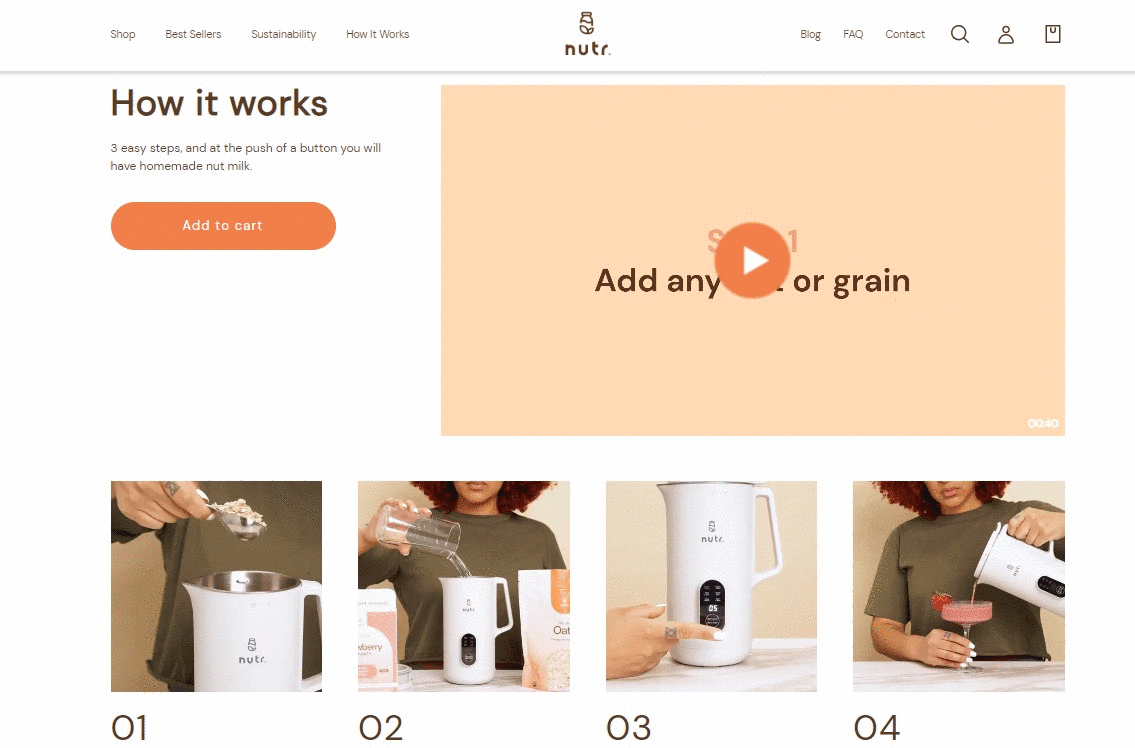
2. Implement personalization at scale
You can tailor the shopping experience to individual preferences with interactive videos. Make video quizzes to understand shoppers’ needs and show them relevant shoppable videos.
Or create branches with your videos to let them explore what resonates the most with them. You can replace generic messaging with these curated videos to convert an "interested viewer" into a "committed buyer."
Case in point: Dr. Dennis Gross
Dr. Dennis Gross, a cruelty-free skincare brand, wanted to guide shoppers in their buying journey and personalize the experience. So, they created a founder video to share more insights about the brand.
As soon as you visit the brand’s website, you’re greeted with a personal message from the founder with multiple options to learn more about their products.
This led to 7% of website visitors actively engaging with videos and watching at least three videos. This engaged traffic also converted at an average rate of 8.2% and led to 5000+ orders.
3. Maximize engagement and conversions
You can convert user-generated content into shoppable videos and build credibility for your brand. Shoppable videos give buyers a one-click checkout process and shorten the path to purchase.
The convenience of watching a product video and making an immediate purchase can significantly help with video conversion rate optimization.
Case in point: Dr Squatch
A men’s personal care product brand, Dr Squatch, wanted to communicate the unique value propositions of their all-natural products and educate shoppers to use chemical-free solutions for personal care.
So, they sourced a lot of user-generated content on TikTok and Instagram and embedded them as interactive videos across their online store. This was helpful in educating shoppers. Plus, the brand also converted all videos into shoppable videos to nudge viewers to instantly purchase a product.
By the time Black Friday Cyber Monday 2022 was live, the brand witnessed 250k views on their videos with an average view time of 1 minute and 40 seconds. They managed to add 5.8k hours to the time spent on the website, leading to 13,500 orders.
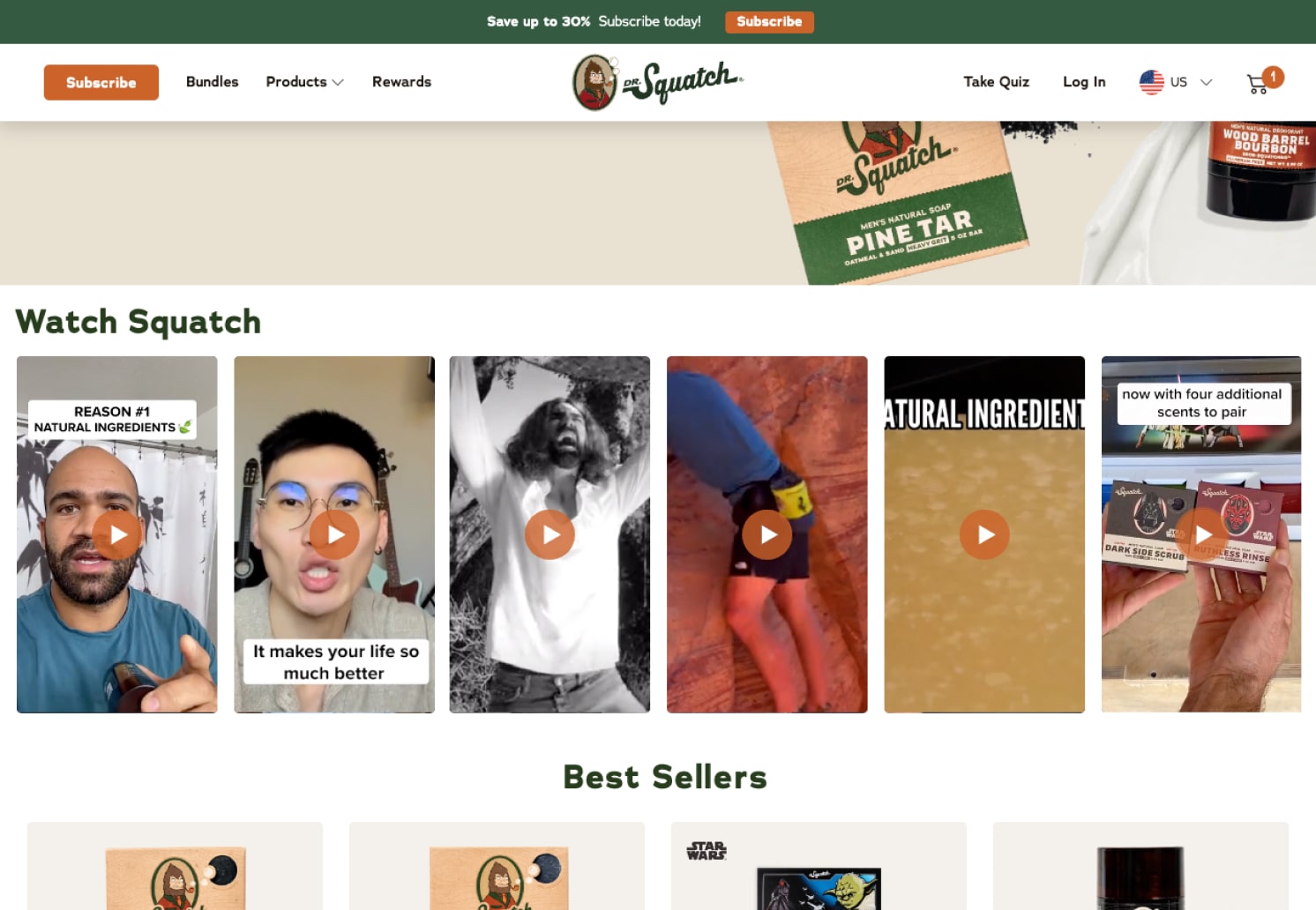
4. Optimized across platforms
You can optimize interactive videos for different devices and channels. Whether buyers are shopping on mobiles, tablets, or desktops, they get a seamless experience with fast page load times and easy navigation—even during peak traffic periods.
This level of optimization also makes it easy to place interactive videos anywhere: on product pages, home pages, checkout pages, etc.
Case in point: True Classic
When True Classic, a DTC men’s wear brand, wanted to rebuild their video infrastructure and embed videos across 700+ product pages, they relied on an advanced video platform like Videowise to do all the heavy lifting.
They replaced Tolstoy and Vimeo with a single powerful solution for optimizing page load times for every product page. Videowise solved this challenge with:
-
Asynchronous small-sized .JS scripts of just 37kb
-
Adaptive bitrate streaming video
-
Lazy-loaded video widgets
-
Compressed assets
The results were extraordinary. The average watcher time for these videos spiked to 1 minute and 21 seconds, and these highly engaged shoppers converted at an average rate of 13%.
5. Create exclusivity with videos
An often missed opportunity among eCommerce brands is leveraging videos for building exclusivity. You can collaborate with influencers to launch premium video content for loyal customers. Alternatively, use videos to award loyalty points—watching a video earns 5 points, sharing a video earns 10 points, and so on. This exclusivity can boost customer engagement and build long-term loyalty.
6. Collect real-time performance data
With the right eCommerce video platform, you can collect data-driven insights to assess your content performance. Stay on top of watcher behavior and see what’s working well in your interactive videos. You can also track how long a viewer hovered over a product, the sequence of products viewed, and where exactly they dropped off.
Pro tip: With Videowise’s detailed analytics dashboard, you can get deeper visibility into your buyer journey from start to finish. Track relevant KPIs like on-site engagement, video conversions, videos watched, sales by device, and many more.
Transforming BFCM with the Power of Interactive Videos
The BFCM season is your time to shine. It’s the perfect opportunity to leverage the power of interactive videos and make a lasting impact on your shoppers.
Start your BFCM marketing campaigns by defining your objectives to understand what you want to achieve. Then, put your creative chops to action and create quality videos that resonate with your buyers. Seek inspiration from successful brands and create a stellar video marketing strategy.
Happy retail holidays to you!
Share

.jpg)
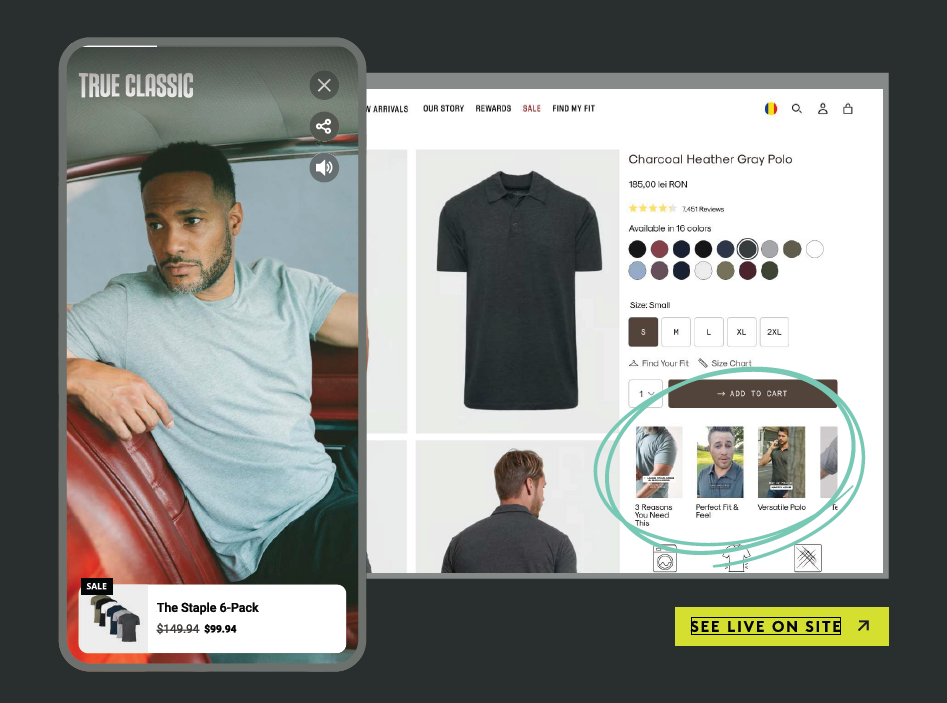


.jpg?width=420&height=420&name=live%20shopping%20top%205%20fashion%20(1).jpg)